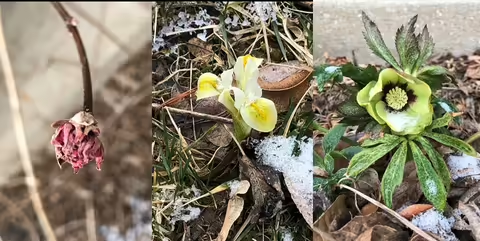Like this time last year, my jungle still has the look of winter sleep, but a few plants are starting to stir, some more than others. As expected, the buds are swelling on Cornelian cherry dogwood (Cornus mas) and my fragrant dawn viburnum (Viburnum bodnantense ‘Dawn’) has broken bud…more on that later. Daffodils (Narcissus), surprise lilies (Lycoris) and Italian arum (Arum italicum) are noticeably pushing up. Hellebores/Lenten Rose/Christmas Rose (Helleborus spp.) are further along than last year, with blooms fully open and foliage in fairly good shape. Evergreen broadleaf perennials like Prague viburnum (Viburnum x pragense), purple stem dwarf sweet box (Sarcococca hookeriana var. humilis 'Purple Stem'), cow’s tail pine (Cephalotaxus harringtonia 'Duke Gardens') or Japanese Sacred Lily (Rohdea japonica) can really look tattered after a rough winter, but not this year. They definitely add a nice green color against the winter drab, but also texture and form beyond the standard evergreen conifers.
I mentioned that my Fragrant Dawn Viburnum is past bud break but not quite to flowering. I have actually found this plant to be rather indicative of the coming spring, at least in my jungle. Over the past five years, I have recorded its budbreak date and if I compare the date for 2020, we should expect an early spring. In 2016 – Feb 9, 2017 – Feb 21, 2018 – Mar 3, 2019 – Mar 14, and this year, 2020 – Feb 2. It will be curious to see if my little shrub is a better prognosticator that the groundhog, because last year the buds didn’t lie, spring was super slow to come.
I previously wrote about my lawn art project where I was fall planting very early emerging bulbs of diminutive stature into my lawn, plants like reticulated iris and crocus. I am flying high on success after spotting the first to bloom this year, a tiny little yellow reticulated iris, named Katherine’s Gold. I can hardly wait to see a lawn full of little beauties. Hopefully like last year, everything will have bloomed before I make the first mowing pass.
Repeating what I wrote last year, regardless of what it looks like outside, the calendar tells me it is time to get prepared for planting the vegetable garden. First is knowing when the last average frost date occurs for the area, because planting dates for different groups of vegetables are based on this date. From state weather records averaged over the last 30 years, I know the median date for the last 32°F freeze for the St Louis metro-east is roughly the 2nd week of April. First to be planted are the cold hardy vegetables, and as you can guess, they like the cold and are tolerant of frost. Cold hardy vegetables need to be planted in the window four to six weeks prior to the area’s last average frost to mature before bolt-inducing heat. For me, February 24 through March 16 is my target window for direct seeding cold hardy vegetables like kale, kohlrabi, leaf lettuce, onion, pea, rutabaga, salsify, spinach and turnip. Soil temperature also plays a factor into early season planting. Pea for example requires a 45°F soil temperature for optimal germination, so avoid planting too early in the target window if soils have not warmed sufficiently.
A number of cold hardy vegetables like broccoli, Brussels sprouts, cabbage and parsley are planted in this same window, but as transplants. For those growing their own transplants, plug trays should have been seeded roughly six weeks prior…the 2nd to 4th week of January. This sounds so easy, but anyone who seeded to schedule last year most likely had transplants ready before the soil had sufficiently warmed. Maybe everyone should have a fragrant dawn viburnum for added information? For the rest of us, purchasing transplants is an easy alternative. This is also the time to source vegetative material for planting horseradish (root), onion (set or plant), potato (tuber), rhubarb (crown or plant) and asparagus (crown).
